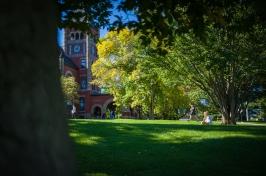Key Research Finding
By analyzing online videos of moose vocalizations, researchers quantified moose calls and determined significant differences in calls by sex and age.
Key Terms
Passive acoustic monitoring: The tracking and monitoring of animals and environments through recording sounds. Kloepper has previously used passive acoustic monitoring to estimate bat colony sizes and frog populations.
Sexual dimorphism: Notable differences in characteristics between sexes of the same species.

Station scientist Laura Kloepper, an assistant professor of biological sciences at the UNH College of Life Sciences and Agriculture, is leading research that analyzes and quantifies moose calls, characterizing them by age and sex. In a recent study published in JASA Express Letters, Kloepper and her co-authors, including NHAES scientist Rem Moll, leverage audio from publicly available online videos to assess wild moose sounds, in their natural environment, and identify the distinct differences by age and sex. It’s a critical first step toward creating an acoustic sensor network in New Hampshire’s North Country to automatically detect and help determine moose population density and occupancy.
“Moose are such iconic wildlife for New Hampshire, so understanding how they’re using their landscape and how we can manage our forests while sharing the land with them is key to their conservation,” Kloepper said. “However, due to the moose’s wide roaming range and its low population densities, monitoring them is an ever-present challenge that can be aided by non-invasive technologies. So to accurately develop a moose acoustic sensor, we first needed to quantify a variety of moose calls — and these data were not available yet, so we crowdsourced it.”
“By tracking moose, scientists can also predict how forest habitat affects moose distribution...we can investigate how habitat disturbance, such as from timber management, affects where moose prefer to live. And we can also investigate if moose’s habitat preference changes with the seasons or time of day.” ~ Laura Kloepper, Assistant Professor of Biological Sciences
Moose have notable differences in characteristics between sexes, and the research team found that this dimorphism extends to vocal differences. Using online videos filmed by hunters and recreationalists and which captured more than 670 moose vocalizations from across the United States, the research team matched the mouth or throat movement to sound. This allowed them to quantify moose calls as well as characterize the calls by age and sex. They found that female moose had calls with higher pitches and longer duration. Moose calves, which remain with their mother for one year and could, therefore, be identified by their proximity to a female moose, had the highest pitched calls, with a duration approximately equivalent to a male.
The study’s development of the first bioacoustic moose vocalizations method is an important first step to creating an acoustic network that can add significant value to ongoing efforts of tracking and monitoring moose populations and, in turn, the effectiveness and impacts of forest and land management practices. Play Audio File: Male moose grunting
“By tracking moose, scientists can also predict how forest habitat affects moose distribution,” said Kloepper. “Specifically, we can investigate how habitat disturbance, such as from timber management, affects where moose prefer to live. And we can also investigate if moose’s habitat preference changes with the seasons or time of day.” Play Audio File: Female moose (cow) barking
Kloepper’s current NH Agricultural Experiment Station work is focused on creating an automated passive acoustic detector capable of determining moose sex and maturity from sound recordings. An initial set of acoustic recorders and monitoring work was established alongside a portion of a statewide camera trap network established in 2021 for non-invasive wildlife tracking by Station scientist Moll, an assistant professor of natural resources and the environment at the UNH College of Life Sciences and Agriculture.
“From the five acoustic monitoring sites we set up, we were able to record 15 moose, including mother and calf grunts, breaths, sniffs and footsteps,” described Kloepper. “For the published paper, we supplemented these data with hunter-contributed video and audio recordings, which allowed us to better quantify the vocal characteristics of male and female moose and calves.”
Kloepper and her team will expand to 50 acoustic monitoring sites in forests in New Hampshire’s Coos County. The recorders will continuously capture sound activity in the morning and evening—times of peak moose activity.
“Although we specifically are interested in recording moose vocalizations, by recording all the sounds we can investigate how the overall acoustic environment—known as the soundscape—varies across forest type,” said Kloepper.
The bioacoustic sites will expand UNH’s passive wildlife monitoring research system, which already includes a network of 300 camera traps set up on private and public lands across New Hampshire by Moll.
“Each year, these cameras capture hundreds of thousands of wildlife images that we analyze to better understand and predict the distribution and abundance of many forest-dwelling wildlife species,” said Moll. “Work by UNH Emeritus Professor Peter Pekins showed that that the primary drivers of regional moose population dynamics are the availability of young forest habitat and winter tick infestations, which can be exacerbated by climate change and locally high moose densities.”
He added, “Technologies like audio and camera stations provide critical population-level data that inform moose conservation and management in a changing world.”
This material is based on work supported by the NH Agricultural Experiment Station through joint funding from the USDA National Institute of Food and Agriculture (under Hatch award numbers 1024128) and the state of New Hampshire.
This work is co-authored by Alex Zager, Sonja Ahlberg, Olivia Boyan, Jocelyn Brierly, Valeria Eddington, Remington Moll and Laura Kloepper.
You can read the published article, Characteristics of wild moose (Alces alces) vocalizations, in JASA Express Letters.
-
Written By:
Maeve Gifford | UNH College of Life Sciences and Agriculture | Maeve.Gifford@mblayst.com

























































